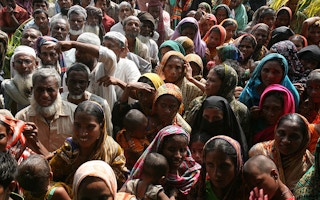Natural disasters – such as this year’s heavy rains, floods and cyclones in India, Bangladesh and Myanmar – have become a talking point at COP23, indicating how such extreme events will increase in a warming globe.
An outcome of such extreme events will be more forced migration, another topic which is slowly finding its place in climate negotiations.
Monsoon floods have displaced hundreds of thousand of people in South Asia this year. Tropical cyclone Mora – and the floods and landslides that came with it — in Bangladesh, Myanmar and India displaced about 851,000 people.
More than 477,000 people were evacuated to shelters in coastal Bangladesh and as the storm moved northeast over land, causing floods and landslides, more people were evacuated. In Myanmar, more than 19,000 people were displaced.
In South Asia, where climate models predict a wetter future, extreme rainfall, intense cyclones and more floods are likely to displace more people in the coming years.
The Internal Displacement Monitoring Centre (IDMC), has placed India on top — along with China and the Philippines — among the countries that face displacement on account of disasters.
Storm and flood events drive most of the displacement in India, Bangladesh and Myanmar. Lowlands, coastlines and islands that flank some of the greatest Himalayan rivers are particularly vulnerable.
“
What we see here is a wide range of mobility outcomes — from evacuation and displacement to short- to long-term migration as adaptation, and planned resettlement.
Soumyadeep Banerjee, migration specialist, International Centre for Integrated Mountain Development
Mobility outcomes
“What we see here is a wide range of mobility outcomes — from evacuation and displacement to short- to long-term migration as adaptation, and planned resettlement,” Soumyadeep Banerjee, a migration specialist with the International Centre for Integrated Mountain Development (ICIMOD), told indiaclimatedialogue.net.
People in the cyclone-affected areas of the Sundarbans in Bangladesh and India narrate how they live on embankments and roads on a higher elevation until floodwaters recede, and then migrate to other villages and towns to work until their submerged fields become arable once again. Often, over the longer-term, people depend on remittances from family members who have migrated.
Policy challenges
The policy challenge is to look at disaster-related mobility comprehensively. “Often governments take a silo approach without an overall view of the problem,” said Banerjee.
It is as though the home affairs office takes care of evacuation and displacement, the relief department deals with resettlement, and the labour departments looks at long-term migration — with officials hardly even sharing notes.
As climate change threats include intense rainfall, the run-off of melt water from the Himalayan glaciers, storm surges of intense cyclones covering more areas, and sea level rise, these factors act together with huge impacts on people’s livelihoods, habitats and mobility.
As Saleemul Huq, director of Dhaka’s International Centre for Climate Change and Development says, it may not be scientifically correct to tag movements in the region as climate-induced at present, but in future there will be large-scale forced migration from areas affected by climate change. “South Asia needs a plan to address this challenge,” Huq told indiaclimatedialogue.net.
Official documents of South Asian states initially mention migration as an outcome of climate change, but they later largely shy away from addressing migration, a sensitive topic in regional politics. India has stated its position on climate change mitigation, adaptation, and loss and damage in its Nationally Determined Contributions (NDCs).
The document notes how rain-fed agriculture covers 60% of the country’s net sown area, with 40% of the total food production affected by frequent droughts, floods, climate variability and extreme weather. The document, however, is silent about climate-related migration. Bangladesh’s NDCs do not mention it either.
In Bangladesh, policies in general are silent about the adaptation potential of migration. However, the country now has a national strategy on the management of disaster and climate induced displacement, the result of several international studies and collaborative work by the United Nations Development Programme (UNDP), the International Organization for Migration (IOM) and local think tanks.
There is also a regional initiative by these organisations and other UN agencies to better understand climate-related migration.
As for regional consultations, a recent knowledge forum discussed human mobility in the context of a changing climate in the Hindu Kush Himalayas, as well as and protection challenges and options.
The delegates — experts and policy makers — stressed the need to integrate human mobility in national policies on climate change, disaster risk reduction and sustainable development across the region.
Experts have been brainstorming on this topic. Huq, for instance, suggests a three-phase plan as people might have to migrate from the country’s low-lying coastal areas in 20 years.
“The idea is to adapt, educate and plan. Right now we need to adapt to changes such as salinity intrusion and flooding,” he told indiaclimatedialogue.net. “Then we need to educate and train boys and girls to future careers away from the coast at international destinations. In the long run, we need to plan, enable and facilitate migration.”
This story was published with permission from The Third Pole. Read the full story.

















